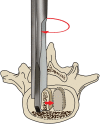Minimally Invasive Transforaminal Lumbar Interbody Fusion and Unilateral Fixation for Degenerative Lumbar Disease
- PMID: 28960820
- PMCID: PMC5656901
- DOI: 10.1111/os.12345
Minimally Invasive Transforaminal Lumbar Interbody Fusion and Unilateral Fixation for Degenerative Lumbar Disease
Abstract
Objective: To evaluate the clinical effect of the minimally invasive transforaminal lumbar interbody fusion combined with posterolateral fusion and unilateral fixation using a tubular retractor in the management of degenerative lumbar disease.
Methods: A retrospective analysis was conducted to analyze the clinical outcome of 58 degenerative lumbar disease patients who were treated with minimally invasive transforaminal lumbar interbody fusion combined with posterolateral fusion and unilateral fixation during December 2012 to January 2015. The spine was unilaterally approached through a 3.0-cm skin incision centered on the disc space, located 2.5 cm lateral to the midline, and the multifidus muscles and longissimus dorsi were stripped off. After transforaminal lumbar interbody fusion and posterolateral fusion the unilateral pedicle screw fixation was performed. The visual analogue scale (VAS) for back and leg pain, the Oswestry disability index (ODI), and the MacNab score were applied to evaluate clinical effects. The operation time, peri-operative bleeding, postoperative time in bed, hospitalization costs, and the change in the intervertebral height were analyzed. Radiological fusion based on the Bridwell grading system was also assessed at the last follow-up. The quality of life of the patients before and after the operation was assessed using the short form-36 scale (SF-36).
Results: Fifty-eight operations were successfully performed, and no nerve root injury or dural tear occurred. The average operation time was 138 ± 33 min, intraoperative blood loss was 126 ± 50 mL, the duration from surgery to getting out of bed was 46 ± 8 h, and hospitalization cost was 1.6 ± 0.2 ten thousand yuan. All of the 58 patients were followed up for 7-31 months, with an average of 14.6 months. The postoperative VAS scores and ODI score were significantly improved compared with preoperative data (P < 0.05). The evaluation of the MacNab score was excellent in 41 patients, good in 15, and fair in 2, suggesting an effective rate of 96.6%. The intervertebral height had reduced 0.2 ± 1.2 mm by the last follow-up, and there were 55 Grade I and II cases based on the Bridwell evaluation criterion. The fusion rate was 94.8%, and no screw breakage and loosening occurred. The scores of physical pain, general health, social, and emotional functioning were significantly increased at the last follow-up.
Conclusion: Minimally invasive transforaminal lumbar interbody fusion combined with posterolateral fusion and unilateral fixation provide a new choice for degenerative lumbar disease, and the short-term clinical outcome is satisfactory.
Keywords: Fusion rate; Lumbar degenerative disease; Lumbar interbody fusion; Posterolateral fusion; Unilateral pedicle screw fixation.
© 2017 The Authors Orthopaedic Surgery published by Chinese Orthopaedic Association and John Wiley & Sons Australia, Ltd.
Figures





References
-
- Bono CM, Lee CK. Critical analysis of trends in fusion for degenerative disc disease over the past 20 years: influence of technique on fusion rate and clinical outcome. Spine (Phila Pa 1976), 2004, 29: 455–463. - PubMed
-
- Polly DW Jr, Santos ER, Mehbod AA. Surgical treatment for the painful motion segment: matching technology with the indications: posterior lumbar fusion. Spine (Phila Pa 1976), 2005, 30: S44–S51. - PubMed
-
- Kabins MB, Weinstein JN, Spratt KF, et al Isolated L4‐L5 fusions using the variable screw placement system: unilateral versus bilateral. J Spinal Disord, 1992, 5: 39–49. - PubMed
-
- Fernández‐Fairen M, Sala P, Ramírez H, Gil J. A prospective randomized study of unilateral versus bilateral instrumented posterolateral lumbar fusion in degenerative spondylolisthesis. Spine (Phila Pa 1976), 2007, 32: 395–401. - PubMed
-
- Moreland DB, Asch HL, Czajka GA, Overkamp JA, Sitzman DM. Posterior lumbar interbody fusion: comparison of single intervertebral cage and single side pedicle screw fixation versus bilateral cages and screw fixation. Minim lnvasive Neurosurg, 2009, 52: 132–136. - PubMed
Publication types
MeSH terms
LinkOut - more resources
Full Text Sources
Other Literature Sources

